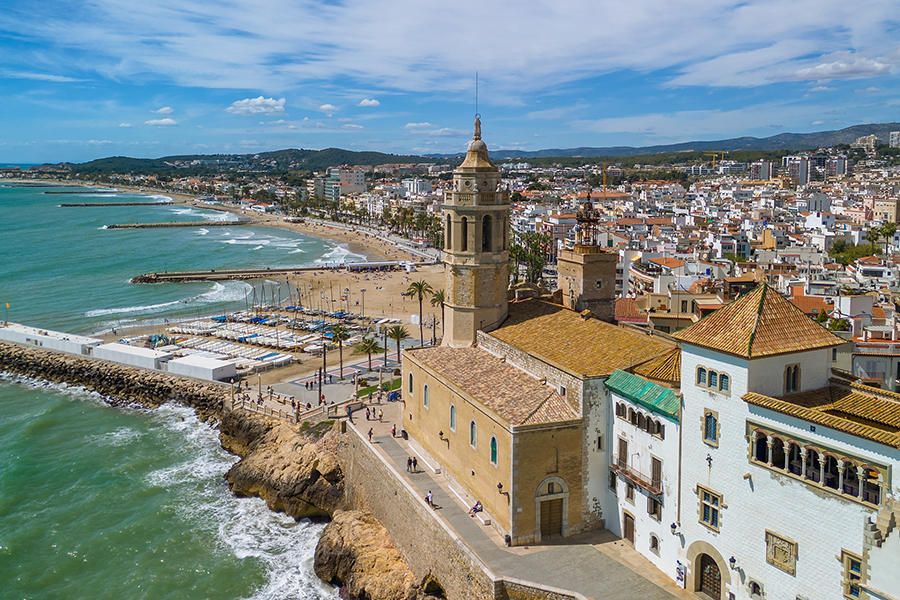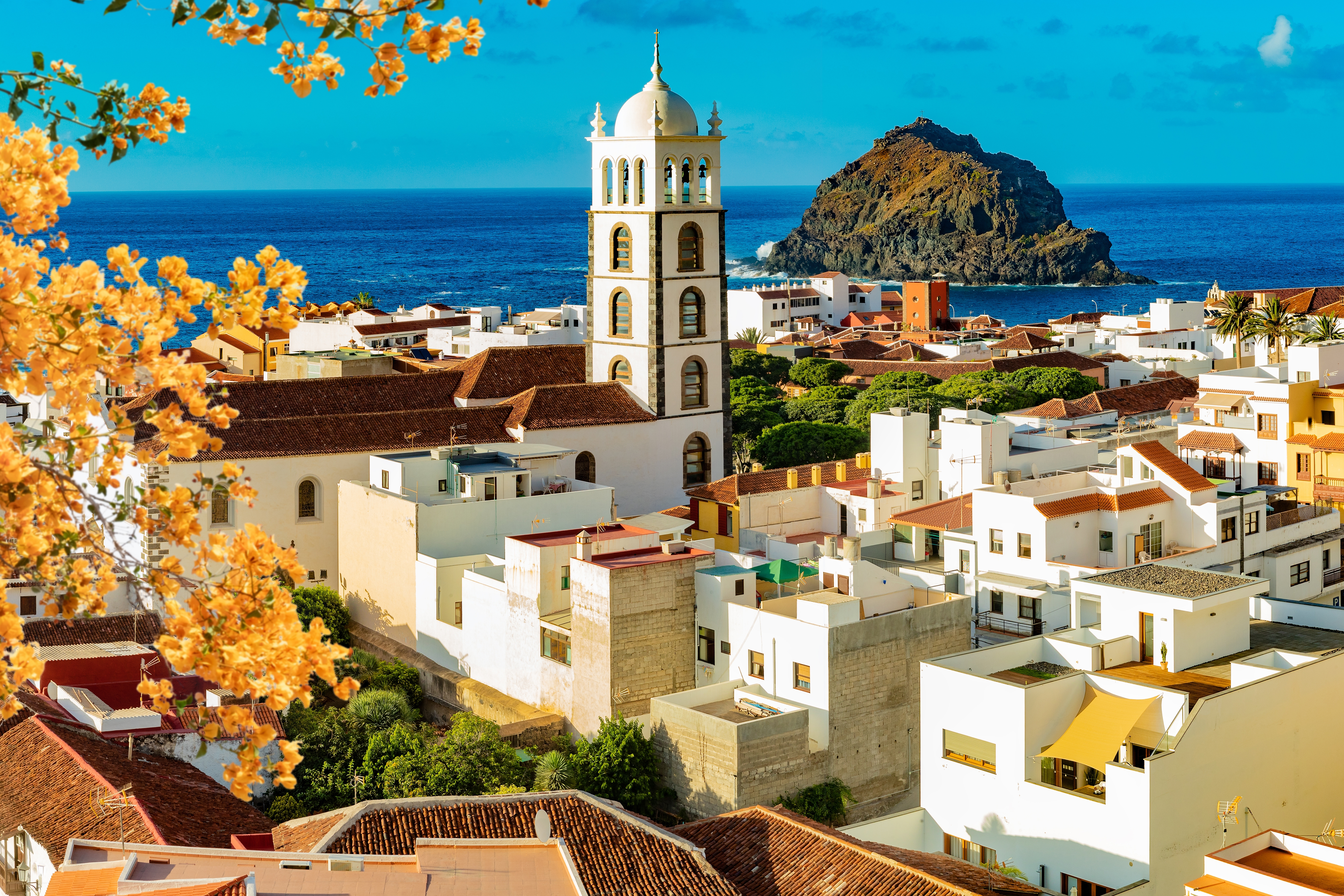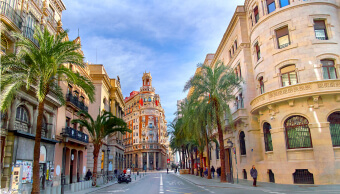You can live comfortably in Spain all over the country, but there are certain regions and cities that immigrants consider the most attractive. Within the autonomous communities, Galicia, Asturias, Basque Country, Castile y Leon, Catalonia, Valencia, Andalusia, Madrid, Castile-La Mancha, Canary Islands are among the best. Foreigners who chose to live in Spain, opt for the most comfortable cities such as Bilbao, Madrid, Barcelona, Tenerife, Aviles and others.
The main criteria for the choice of region and settlement – the cost of living, opportunities for employment, education, business, transportation infrastructure, environmental safety. Before you apply for a Spanish residence permit and settle in the country, you should consider various options for a place of residence and choose the best one, based on your goals, family circumstances, budget and other factors, as future comfort depends on it.

Best Places to Live in Spain: Top Cities and Regions
Spain is divided into 17 autonomous communities and includes hundreds of cities, the largest being Madrid, Barcelona and Tenerife. The crowdsourcing platform Livingcost presented a ranking of the best places to live in the country. The study factored in GDP, crime, air pollution, transportation accessibility, income-to-expense ratio, and other criteria.
The top ten best cities to live in Spain include Madrid, Barcelona, Ospitalet de Llobregat, Alcalá de Henares, Valencia, Alicante, Elche, Seville, Gandia and Bilbao. In these areas people live quite comfortably, yet they are not as expensive as in the large urban centers of other Western European countries.
Best Cities to Live in Galicia: Pontevedra, Lugo, Vigo
Galicia is located in northern Spain and has a population of approximately 2,700,000. The region has one of the highest GDPs in the country, affordable housing rents, and transportation accessibility courtesy of three airports and high-speed rail service. Galicia is attractive to entrepreneurs and immigrants looking for work. The local government’s policy is to support business, with more than 50,000 jobs created by foreign investors.
Many international companies are located in the region, including industrial giants such as PSA Groupe Citroën DS Peugeot (France), Bosch (Germany) and Nestlé (Switzerland). Among the most common jobs advertised by Galician companies are electrical engineers, salesmen, managers and chefs. The community also attracts foreign candidates, students and researchers, with three universities, a supercomputer complex, a center for innovative technologies and the Royal Galician Academy of Sciences.
The region also boasts more than 2,000 kilometers of beaches, a rich cultural life, diverse cuisine and high-quality food production. The following figures show the average income level and cost of living per person in Galicia, as well as rental prices for housing.
| Pontevedra | |
|---|---|
| Average salary, € | 1 200 |
| Cost of living, € | 516 |
| Rent, € | 300–450 |
| Lugo | |
| Average salary, € | 1 603 |
| Cost of living, € | 425 |
| Rent, € | 500–700 |
| Vigo | |
| Average salary, € | 1 500 |
| Cost of living, € | 570 |
| Rent, € | 465–600 |
Best Cities in Asturias: Gijon, Oviedo, Aviles
Asturias is located on the northern coast of Spain and is home to more than 1,022,000 people, of which approximately 40,000 are foreigners. The region is suitable for expatriates who are attracted by the tranquil rural lifestyle. Those looking to buy property in Spain at an affordable price can find plenty of options for houses with gardens in the countryside. The major cities of Gijon, Oviedo and Aviles are home to many companies, universities and vocational training centers.
Business development in the region is facilitated by economic projects of local authorities, access to European aid programs, technology centers, the Zalia logistics zone near the port of Gijon, broadband Internet throughout the area. Several foreign companies have opened representative offices in Asturias – EDP (Portugal), Bayer (Germany), Nestlé (Switzerland), Ricoh (Japan), among others.
The approximate level of income and cost of living per adult in the leading cities of the region are shown in the following table:
| Gijon | |
| Average salary, € | 1 868 |
| Cost of living, € | 590 |
| Rent, € | 450–600 |
| Oviedo | |
| Average salary, € | 2 130 |
| Cost of living, € | 556 |
| Rent, € | 390–616 |
| Aviles | |
| Average salary, € | 1 550 |
| Cost of living, € | 354 |
| Rent, € | 350–500 |
According to immigrants, further benefits of Asturias are its picturesque nature with clean rivers, old forests and secluded beaches, as well as a variety of historical monuments from different periods, including ancient Celtic ruins.
For financially independent people who want to move to one of the most beautiful regions of Spain, iWorld is ready to provide legal assistance, including paperwork and support at all stages of the .
Where to Live in the Basque Country: Bilbao, San Sebastian, Vitoria
The Basque Country is considered one of the best regions of Spain, located on the coast of the Cantabrian Sea (Bay of Biscay), bordering France. The population is over 2,178,000, of which 6.37% are foreigners. The Basque Country is often chosen by retirees (in 2022 there were 4,452 immigrants aged 60-64), entrepreneurs, specialists in various fields of activity.
Among the advantages of the region is a well-developed transportation network. There are two airports in the area – international and domestic flights, suburban and intercity rail system, operate buses, and there is a subway. The Basque Country offers a wide range of sports and cultural activities – hiking and cycling routes, mountaineering, surfing, kayaking, in Bilbao and other cities there are museums, art galleries, theaters, concert halls.
The region offers conditions for doing business and employment opportunities in various fields of activity. The following table shows the number of companies and jobs in different sectors in July 2024.
| Industry | Number of companies | Number of jobs |
| Automotive | 300 | 100 000 |
| Energy Sector | 342 | 63 364 |
| Electronics and ICT | 258 | 19 276 |
| Machine Tool | 128 | 7 489 |
| Aerospace | 52 | 14 586 |
| Biosanitary | 150 | 7 300 |
| Green | 436 | 15 700 |
| Logistics and mobility | До 100 | 26 235 |
| Food manufacturing | 246 | 6 286 |
Research companies, start-ups, environmental investors and some other categories of businesses can count on tax incentives and deductions. There is a shortage of human resources in the region, and the Basque authorities plan to attract around 10,000 foreign professionals each year to fill the gap.
The approximate income levels and cost of living per person in the region’s main cities are shown in the following table:
| Bilbao | |
| Average salary, € | 2 230 |
| Cost of living, € | 650 |
| Rent, € | 680–880 |
| San-Sebastian | |
| Average salary, € | 2 556 |
| Cost of living, € | 660 |
| Rent, € | 690–930 |
| Vitoria-Gasteiz | |
| Average salary, € | 1 860 |
| Cost of living, € | 575 |
| Rent, € | 695–790 |
Top Cities in Castilla y León: Burgos, Salamanca, Valladolid
The region is located in the north of Spain, on the border with Portugal, and includes 9 cities. The total population is about 2.4 million inhabitants. 123,000 of them are foreigners. The capital of Castilla y León is Valladolid. The region is the largest in the country and is characterized by political, economic and social stability, which attracts investors and entrepreneurs. Financial and other support is available to business owners through the government’s ICE program.
Castilla y León is one of the five safest regions in Spain. The public transportation network includes buses and trains. Most jobs are in the service, manufacturing and construction sectors. The region is also home to representative offices of large multinational corporations – Renault (in Valladolid), Michelin (in Burgos), and others.
Castilla y León is also a good place to move for young people who want to study, as there are several major universities in the region, including the Universities of Salamanca, Burgos, Valladolid and Leon. The average cost of living in the main cities of the region (per person) is shown in the following table:
| Burgos | |
|---|---|
| Average salary, € | 1 940 |
| Cost of living, € | 525 |
| Rent, € | 450–570 |
| Salamanca | |
| Average salary, € | 1 600 |
| Cost of living, € | 500 |
| Rent, € | 340–490 |
| Valladolid | |
| Average salary, € | 1 700 |
| Cost of living, € | 600 |
| Rent, € | 440–600 |
Best Places to Live in Catalonia: Barcelona, Girona, Tarragona
Catalonia is located in the northeast of Spain, bordering France and washed by the Mediterranean Sea. The region is popular with foreigners, having a total population of about 7,600,000, of which about 1,082,000 are immigrated. Catalonia is a destination of choice for people who want to develop a business or have a high-paying job, as well as for retirees. In 2022, more than 37,000 immigrants aged 60-64 were living here.
The region is known for its highly developed industry, with more than 600,000 companies, the main sectors being food manufacturing, automotive, chemical and pharmaceutical products. Catalonia is also one of the most important European ICT centers; King, Amazon, HP, Nestlé, Roche and other leading global companies have opened their technological and research offices in the area.
The region’s cities offer a well-developed public transport system (comfortable buses, trains and, in Barcelona, a subway) and are friendly to cyclists and pedestrians. The region’s advantages also include the presence of world-class sports centers, many natural and architectural attractions, a variety of restaurants and cafes, including one of the best in the world, El Celler de Can Roca (Girona).
The average monthly income and expenses of a person in Catalonia are shown in the following table:
| Barcelona | |
| Average salary, € | 2 150 |
| Cost of living, € | 730 |
| Rent, € | 850–1 095 |
| Tarragona | |
| Average salary, € | 2 025 |
| Cost of living, € | 540 |
| Rent, € | 470–625 |
| Girona | |
| Average salary, € | 1 710 |
| Cost of living, € | 547 |
| Rent, € | 626–950 |

Best Cities in Valencia Region: Valencia, Castellon, Alicante
The autonomous community of Valencia is located in the east of Spain and is characterized by a warm, sunny climate, a long coastline and picturesque nature with mountainous and rural landscapes. The total population of Valencia is about 5,000,000, of which about 661,000 are foreigners, with about 40,000 immigrants aged 60-64.
As the regional capital, Valencia attracts young people, professionals, students and entrepreneurs. According to the Expat City Ranking 2022 study, immigrants ranked it as the best city in the world to live in. The provinces of Castellon and Alicante offer a more relaxed way of life, ideal for families with children and retirees.
The transportation system of the autonomous community includes an extensive network of bus and tram lines connecting towns and villages. The region also has a well-developed bicycle infrastructure, with bike rentals available.
Valencia is considered the logistics center of Southern Europe, which makes the region attractive for business development. There are 4 private and 5 public universities, 5 science parks, technological institutes, research centers, incubators and many co-working spaces in the community. The approximate cost of living per adult and average monthly salaries for the region are shown in the following table:
| Valencia | |
| Average salary, € | 2 195 |
| Cost of living, € | 628 |
| Rent, € | 660–870 |
| Castellon de la Plana | |
| Average salary, € | 1 840 |
| Cost of living, € | 500 |
| Rent, € | 470–570 |
| Alicante | |
| Average salary, € | 1 553 |
| Cost of living, € | 595 |
| Rent, € | 586–776 |
Where to Live in Andalusia: Seville, Granada, Cordoba
Andalusia is a southern region of Spain that attracts immigrants with its mild climate, steadily growing economy, and high quality of life. The community has a population of more than 8,400,000 inhabitants, of which approximately 650,000 are foreign nationals.
The advantage of setting up a business in Andalusia is its strategic geographical location, offering access to European, African, Asian and Latin American markets. The community is home to around 1,500 innovative companies with a total of more than 52,800 jobs. The region also has free zones with tax incentives for new businesses.
Hundreds of job opportunities are available in Seville, Granada and other cities. Common jobs include business analyst, promoter, customer service representative, sales representative, salesperson, accountant, and software developer. The transportation system includes 5 international airports, 10 ports, high speed trains and highways. Approximate income and expenses per person in Andalusia are shown in the following table:
| Seville | |
| Average salary, € | 1 640 |
| Cost of living, € | 600 |
| Rent, € | 520–770 |
| Granada | |
| Average salary, € | 1 830 |
| Cost of living, € | 580 |
| Rent, € | 470–540 |
| Cordoba | |
| Average salary, € | 1 450 |
| Cost of living, € | 500 |
| Rent, € | 410–570 |

Best Cities in Madrid Region: Madrid, Alcalá de Henares, Mostoles
The Madrid community is located in central Spain. The region is home to approximately 6,500,000 people, of which more than 795,000 are immigrants. The community is considered one of the most prosperous in the country and offers a wide range of employment opportunities. The greatest demand for professionals is in the service sector, tourism and hospitality, technology and innovation, healthcare and banking.
With over 500,000 companies operating in the region, Madrid is one of the top five cities in Europe to host multinational corporations. Foreign students come to the region to get a quality education, with 12 universities and prestigious business schools – Instituto de Empresa, IESE, EOI, ESIC and others.
Madrid is the largest European highway and rail hub. The region is home to Barajas International Airport, the fourth busiest in Europe in terms of passenger traffic. Salaries and cost of living are higher than in other cities.
| Madrid | |
| Average salary, € | 2 362 |
| Cost of living, € | 740 |
| Rent, € | 800–1 120 |
| Mostoles | |
| Average salary, € | 1 450 |
| Cost of living, € | 638 |
| Rent, € | 775–970 |
| Alcalá de Henares | |
| Average salary, € | 1 460 |
| Cost of living, € | 550 |
| Rent, € | 490–586 |
Where to Live in Castilla-La Mancha: Albacete, Ciudad Real, Cuenca
Castile-La Mancha is located in the center of Spain and is home to more than 186,000 foreigners out of a total population of around 2,045,000. This autonomous community is smaller than other Spanish regions, so job opportunities are not as wide, but it is possible to find vacancies in the sectors of tourism, agriculture and food manufacturing industry.
The authorities of Castile-La Mancha have developed a strategy to strengthen the economy, the Plan Forward, the FOCAL program and the Plan Adelante, which provides support for investors. Another advantage for entrepreneurs is the great amount of industrial land available. The region has a well-developed transportation infrastructure, including a network of highways and high-speed railroads. Car and bicycle rentals are also available in the cities.
The approximate cost of living per person in Castile-La Mancha, salary levels, and rental rates for housing are shown in the following table:
| Albacete | |
| Average salary, € | 1 783 |
| Cost of living, € | 516 |
| Rent, € | 330–450 |
| Ciudad Real | |
| Average salary, € | 1 466 |
| Cost of living, € | 475 |
| Rent, € | 300–400 |
| Cuenca | |
| Average salary, € | 1 183 |
| Cost of living, € | 456 |
| Rent, € | 450–600 |
Top Places to Live in Canary Islands: Las Palmas, Tenerife, La Laguna
The island province of Spain is home to more than 2,100,000 people, including about 260,000 foreigners. The largest cities are Las Palmas de Gran Canaria, Santa Cruz de Tenerife and Cristobal de La Laguna. A significant proportion of immigrants are business owners and employees, as well as their family members.
The most remote European region attracts entrepreneurs with a favorable tax climate, the lowest corporate tax and VAT rates in the EU – 4% and 7%, respectively. High-tech sea and air transportation, developed telecommunications provide connection with the continents, which allows to develop business on the market not only in Europe, but also in Africa. Offshore oil and gas production, outsourcing and data centers, ICT, R&D, astrophysics and others are considered to be the key areas of entrepreneurship.
Among the advantages of the region are also a multicultural local community, high quality health care (28 hospitals and 103 medical centers), developed education system, including 39 private schools and 5 universities. The climate of the Canary Islands is considered to be the best in the world, with an average annual temperature of 22°C and approximately 4800 hours of daylight per year.
The following table shows the average income and cost of living in the region:
| Las-Palmas de Gran Canaria | |
| Average salary, € | 1 313 |
| Cost of living, € | 1 313 |
| Rent, € | 580–640 |
| Santa Cruz de Tenerife | |
| Average salary, € | 1 380 |
| Cost of living, € | 550 |
| Rent, € | 560–620 |
| San Cristobal de La Laguna | |
| Average salary, € | 1 440 |
| Cost of living, € | 537 |
| Rent, € | 590–670 |
The Canary Islands are recognized as an ideal place to live, so this region is often chosen by freelancers and remote workers who immigrate here on a Nomad Visa to Spain.
To move to the Canary Islands, all you need to do is apply for a Nomad Visa to Spain. At the same time, you can obtain an annual visa for family members, which gives you the right to apply for a 3-year residence permit.

How to Choose the Best City to Live in Spain
The main criteria for choosing the best place to live in Spain are:
- Cost of living. In order to properly calculate your budget, at least for the first time, it is important to analyze how much it costs to live in a particular region of Spain. The best places to live according to the aspect are Lugo and Aviles.
- Employment prospects. This is an important criterion for those who plan to earn an income from work and are considering employment. Places with a high concentration of companies in different sectors offer the most opportunities in this respect. It is possible to live comfortably and hold a well-paid job in Barcelona, Seville and Valencia.
- Entrepreneurial opportunities. Business development is facilitated by the city’s advantageous geographical location, favorable investment climate, developed logistics, and local government’s business support programs. Foreigners who want to move to Spain and establish a company in its territory choose Madrid, Bilbao, Albacete, Santa Cruz de Tenerife.
- Environmental safety. Air pollution affects health and quality of life, which is especially important for older people and families with children. If this is an important factor for a foreigner planning to live in Spain, it is better to choose a city with excellent environmental indicators, such as Vigo or Alcalá de Henares.
- Educational setting. Having educational institutions and university campuses in your place of residence will allow you to save a lot of money and travel time. Valencia, Burgos, Salamanca, Valladolid and Valencia offer a wide range of educational opportunities.
- Recreational opportunities. Retirees, financially independent people choose to live in cities that offer a wide range of activities and cultural entertainment, as well as beautiful nature and beach infrastructure. Alicante, Lugo, Vigo, Bilbao, San Cristobal de La Laguna attract fans of quality leisure.
Whenever possible, it is worth visiting a particular region for a period of time, e.g. on a tourist visa or under the free movement regime, before making a permanent move, in order to experience the pros and cons. Whether or not you qualify for visa-free entry depends on your nationality – if you do, you can usually live in Spain without a visa for a maximum of 90 days per half-year.
In any case, to live in Spain for a longer period of time, you will need to establish residency. iWorld specialists are ready to find a suitable immigration program and provide comprehensive support.
Get advice

















